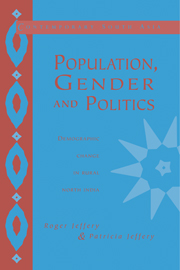Book contents
4 - Women's agency and fertility
Published online by Cambridge University Press: 07 January 2010
Summary
In cities, big people ask a girl before making an engagement, but no one asks a girl in a village. The girl doesn't even know which boy she is being married to.
(Janistha w/o Jabir, S8, landless, no schooling)My parents didn't look for a boy anywhere else than Nangal – though if they had done so what would I know, where do men tell these things inside the house? Men generally go outside and they do not tell outside matters inside the house. No opinion was sought from me about my marriage.
(Lalita's sister-in-law)Who used to ask girls' opinions previously? Even if a girl was thrown in a well, she couldn't say anything.
(Lalita w/o Lokender, J9, landlord, 8th class pass)Narrow class-based theories of demographic change have been subjected to several powerful criticisms. For example, the so-called ‘new household economies’, associated with the work of Gary Becker (1960) has been accused of failing to take into account the possibility of gender-and age-based conflicts of interest within the household. Until the 1980s, most discussions failed to recognize that men's and women's views might be different, and affected by the structured inequalities between them (as Cain et al. 1979 and Basu 1991, point out). Asok Mitra (1978) was one of the first writers to stress the possibility that the ‘status of women’ might play a major role in understanding demographic change in India. Since then, demographic orthodoxy (following the work of Karen Mason 1984) includes variables on women's status in its model-making.
- Type
- Chapter
- Information
- Population, Gender and PoliticsDemographic Change in Rural North India, pp. 117 - 164Publisher: Cambridge University PressPrint publication year: 1997
- 1
- Cited by



